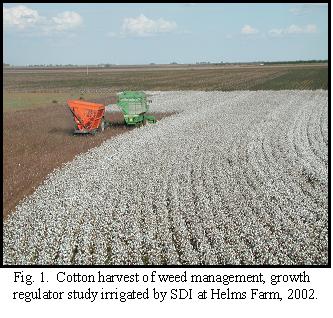(Field 6H)
Wayne Keeling, John Everitt and Leanna Lyon
 Objective: The objectives were to:
Objective: The objectives were to:
1) Evaluate the effectiveness of two herbicide scenarios on weed control and lint yield.
2) Evaluate a new plant growth regulator against mepiquat chloride.
Methodology: Paymaster 2326 BG/RR and Fibermax 989 BG/RR were planted on May 6, 2002 in three replications (16 rows x 250’ long) in a subsurface drip irrigated field. The seasonal herbicide scenarios were as follows: 1) Prowl (pre-plant incorporation) followed by a broadcast application of Roundup Ultra Max (post-emergence) followed by post-directed spray of Roundup Ultra Max and 2) Broadcast application of Roundup Ultra Max (post-emergence) followed by post-directed spray of Roundup Ultra Max. Plant growth regulator (PGR) treatments were 1) Pix Plus/BAS, a new PGR, and 2) mepiquat chloride, the original PIX. Weed control was observed during the growing season and lint yield was determined after harvest. A total of 15.1 inches of water was applied through the sub-surface drip irrigation system.
Results: Due to very low rainfall and subsurface drip irrigation, pigweed pressure was light and both the Prowl + Roundup UltraMax and the Roundup UltraMax only scenarios provided effective season-long weed control (Table 1.). Similar cotton yields were produced with either PGR treatment. FiberMax 989 BG/RR produced the highest lint yield at 2069 lb./ac.
| Table 1. The effect of two herbicide treatments on pigweed adn venice mallow weeds and on lint yield of Paymaster 2326 BG/RR and Fiber Max 989 BG/RR cotton. | ||||
| Treatment | Weed Control July 31 (%) | Cotton Yield (lb/ac) | ||
| Pigweed | Venice Mallow | Paymaster | Fiber Max | |
| 2326 BG/RR | 989 BG/RR | |||
| Prowl + Roundup Ultra Max | 100 a1/ | 100 a | 1746 a | 1962 a |
| Roundup Ultra Max only | 100 a | 100 a | 1806 a | 2069 a |
| 1/Means followed by the same letter do not significantly differ (P=0.05, LSD) | ||||

